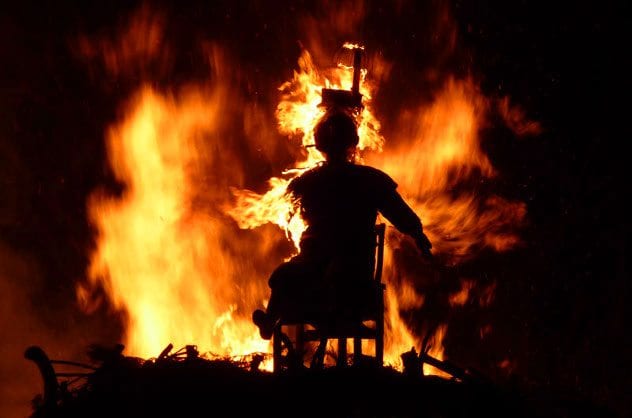 Mysteries
Mysteries  Mysteries
Mysteries  History
History 10 Surprising Stories About the Texas Rangers
 Humans
Humans 10 Philosophers Who Were Driven Mad by Their Own Theories
 Miscellaneous
Miscellaneous 10 Video-Game-Worthy Weapons and Armors from History
 Weird Stuff
Weird Stuff 10 Psychics Who Accurately Predicted Wartime Events
 The Arts
The Arts 10 Pieces of Art Inspired by a Broken Heart
 Health
Health 10 Science Fiction-Sounding New Medical Treatments
 History
History 10 Surprising Facts About the Father of Submarine Warfare
 Space
Space Ten Astonishing New Insights into Alien Worlds
 Weird Stuff
Weird Stuff 10 Bizarre Summer Solstice Rituals Still Practiced Today
 Mysteries
Mysteries Top 10 Haunting Facts About the Ghost Ship MV Alta
 History
History 10 Surprising Stories About the Texas Rangers
 Humans
Humans 10 Philosophers Who Were Driven Mad by Their Own Theories
Who's Behind Listverse?

Jamie Frater
Head Editor
Jamie founded Listverse due to an insatiable desire to share fascinating, obscure, and bizarre facts. He has been a guest speaker on numerous national radio and television stations and is a five time published author.
More About Us Miscellaneous
Miscellaneous 10 Video-Game-Worthy Weapons and Armors from History
 Weird Stuff
Weird Stuff 10 Psychics Who Accurately Predicted Wartime Events
 The Arts
The Arts 10 Pieces of Art Inspired by a Broken Heart
 Health
Health 10 Science Fiction-Sounding New Medical Treatments
 History
History 10 Surprising Facts About the Father of Submarine Warfare
 Space
Space Ten Astonishing New Insights into Alien Worlds
 Weird Stuff
Weird Stuff 10 Bizarre Summer Solstice Rituals Still Practiced Today
10 Barbaric Forms Of Punishment Still Practiced Today
It is the belief of some that as humanity advances, so to do our moral values. When we look at history, this becomes evident. Slavery was once practiced and accepted as legitimate all over the world, whereas today it is all but eradicated. In the realm of criminal justice, we have seen a slow but widespread phasing out of many corporal punishments deemed as exceptionally cruel. Unfortunately, there remain some isolated places and people which continue to practice some of these heinous forms of punishment. This list will look at ten of the most barbaric forms of punishment that are still practiced today.
10 Flogging

Flogging is a punishment in which a person is beat with a whip or a rod. The punishment was common up until the 19th century when it was gradually replaced by other forms of punishment, primarily imprisonment.
Today flogging is widely condemned by organizations such as the United Nations and Amnesty International as being an excessively cruel form of punishment, and it has been outlawed in many countries. Yet there are still some nations which continue to practice flogging as a form of punishment including Saudi Arabia, Iran, and Sudan. In the countries that still practice flogging, the punishment can be administered to men, women, and children for a number of seemingly minor crimes, and it often takes place in public.
In one particularly well-known case in 2014, a Saudi man named Raif Badawi was sentenced to 1,000 lashes and ten years in prison for “insulting Islam” on an online blog. His conviction and punishment have been protested by thousands worldwide. Despite international outcry, flogging remains an accepted form of punishment in some places.
9Caning

Similar to flogging, caning is a form of punishment in which a person is beaten with a cane. The strikes from the cane can be extremely painful as they often break the skin and result in scarring. Like flogging, caning has been widely condemned, and yet it remains a brutal form of punishment in some places.
One of the most prolific users of caning is the Republic of Singapore. In 2012 alone, Singapore carried out 2,203 caning sentences, many of which were given to illegal immigrants and vandals. Just recently, two Germans students studying in Singapore were sentenced to nine months in prison and three strokes of the cane after they were caught spray-painting graffiti on a train.
Despite the protest of numerous human rights groups, and an international charter prohibiting cruel and degrading forms of punishment, Singapore and a few other countries continue to defend the legitimacy of these harsh punishments.
8Solitary Confinement

When it comes to punishment, we often consider the ones which induce physical pain as being the barbaric methods. Yet many consider the punishment of solitary confinement to be barbaric, as it mentally and psychologically harms those who experience it. Solitary confinement is the total isolation of a prisoner. It is reserved for only the worst criminals and those who pose a danger to the rest of the prison population. These inmates often spend anywhere from 22-23 hours alone in a small cell, with only an hour or so allocated for outdoor recreation.
Solitary confinement has been denounced by the United Nations, as well as other human rights groups, but it continues to be used in some places, including the United States, which currently has around 80,000 prisoners in solitary confinement. One report by the Human Rights Watch describes the experience of solitary confinement as “the absence of normal social interaction, of reasonable mental stimulus, of exposure to the natural world, of almost everything that makes life human and bearable . . . [it] is emotionally, physically, and psychologically destructive.”
7Dismemberment

One of the most shocking forms of punishment still utilized is dismemberment (also known as amputation). Dismemberment is the removal of any appendage such as an arm, leg, hand, or foot.
Depending on the case and the location, the dismemberment may be done in a medical environment by doctors forced to perform the operation, in which case, the convicted will be unconscious. In other cases, the convicted may not be so lucky, and the dismemberment will be carried out through much cruder methods, with hands and feet being cut off without any anesthetic at all.
In some countries like Saudi Arabia, Iran, and Sudan, hands and feet are often cut off for various crimes. It is a tradition that finds its base in Islamic Sharia Law, which calls for thieves to be punished by losing a hand. In some instances, “cross amputation” is used as a punishment for crimes such as armed robbery in which the right hand and the left foot are both cut off.
The use of dismemberment as a punishment has been condemned as torture, and completely contrary to human rights, by many prominent international rights groups. Yet this grotesque form of justice remains a firm tenant of law in many of the countries that implement Sharia Law.
6Blinding

As of 1979, Iran has been governed by Sharia Law. One particular aspect of the law known as “qesas” permits physical retribution against criminals who have committed violent crimes. This is based on the ancient principle of an “eye for an eye.” This law allows for horrific physical punishments to be leveled against criminals, including the punishment of blinding.
In this punishment, one or both of the criminal’s eyes are blinded by either gouging or acid. It is typically used as retribution in cases where a victim is left blinded by an attack. In Iran, this type of revenge is not uncommon, as horrific acid attacks, meant to blind and disfigure the victim, occur all too frequently. Iran is not the only place to employ the use of blinding; the punishment is also used in Saudi Arabia.
5Beheading

Many people may be shocked to hear that beheading is a form of execution that is still in use today. However, it is the disturbing truth. The Islamic State (ISIS) has been known to behead captives, enemy soldiers, and hostages on a large scale. These beheadings are often carried out in public and are typically filmed and put online. The Islamic State is a blood thirsty terrorist group, and unfortunately, such heinous violence has come to be expected from them.
However, there is one sovereign nation recognized by the international community that also practices beheading: Saudi Arabia. Saudi Arabia follows a strict interpretation of Sharia Law that allows for certain crimes such as rape, murder, apostasy, and drug trafficking, among others, to be punishable by death. These executions are often by decapitation, with the convicted person’s head being chopped off with a sword in public. In 2015, Saudi Arabia executed at least 157 people, many of whom were beheaded. Despite international pressure, the rate of beheadings and executions in Saudi Arabia continues to rise.
4Stoning

Stoning is a form of execution in which a group of people hurl stones at a person convicted of a crime (usually adultery) until they are dead. Disturbingly, this barbaric form of punishment is still used in some places around the world. Stoning is a legal form of execution in Iran, Saudi Arabia, Sudan, United Arab Emirates, Pakistan, and Yemen. Although technically illegal, it also occurs in parts of Afghanistan, Somalia, Nigeria, Mali, Malaysia, and Iraq.
Adultery is the crime which typically receives the punishment of stoning. However, it should be noted that women are much more likely to be convicted or suspected of adultery than men, and therefore, women make up the majority of stoning victims. In one particularly horrific 2008 case, a young girl was stoned to death in Somalia in front of thousands of people. Amnesty International reported that the girl was only 13 years old and had been convicted of adultery after she tried to report that she had been raped to the Islamist group that controlled the area.
3 Crucifixion

Crucifixion is a form of execution in which a person is nailed to a cross and left to slowly die. It may take hours or even days for the person to die and is extremely painful. While most consider the punishment of crucifixion to be one that died out long ago, crucifixion does still occur. ISIS militants have been known to crucify those who attempt to resist them.
However, there is also another place where crucifixion is known to occur. Yep, you guessed it, Saudi Arabia. Under the Saudi penal code, crucifixion is a legal form of punishment and execution. In one case that has drawn international attention, the Saudi government sentenced a 17-year-old boy named Ali al-Nimr to crucifixion for his participation in anti-government protests. In Saudi Arabia, crucifixion takes place after death with the dead body being crucified in a public place to serve as a warning to others. Amnesty International has condemned the act as “the ultimate form of cruel, inhuman and degrading punishment.”
2Premature Burial

Premature burial is when a person is buried alive as a way of killing them. Being buried alive is a nightmare situation; the mere thought of it terrifies most people. Yet in recent years, with the growth of the Islamic State, we have seen a reemergence of premature burial as a means of execution.
In 2014, a report emerged that Islamic State militants had killed hundreds of members of the Yazidi minority group after they resisted the Islamic State. According to the report, they buried alive numerous women and children. According to other reports, ISIS also buried alive some of their own soldiers as punishment for fleeing the battlefield.
Premature burial has also been reported in parts of Turkey. In one particular case, a Turkish girl of 16 was buried alive by her family in their garden in a so-called “honor killing.” Turkey has been attempting to crack down on honor killings, which occur when a girl or woman is deemed to have disgraced the family, and thus, must be killed to restore the family’s honor. Although rare, honor killings and premature burial continue to occur in Turkey.
1Death by Burning

Perhaps the most horrific means of death, death by burning was a popular means of execution in medieval times, often reserved for those convicted of witchcraft, heresy, and treason. Shockingly, death by burning as a form of punishment and execution continues to be used in some areas of the world. ISIS has burned hundreds of people alive, often filming the executions. In 2014, they burned alive 26-year-old Moaz al-Kasasbeh, a captured pilot from Jordan, in a horrific display of cruelty.
However, it is not just ISIS. In Kenya, there is an ongoing problem of villagers burning alive people suspected of witchcraft. Similarly, in places where there is little law enforcement, or the people do not trust the police, they may decide to take justice into their own hands, sometimes becoming judge, jury, and executioner. In Guatemala, in 2015, a 16-year-old girl was burned alive by a mob for her alleged part in the murder of a taxi driver. In 2016, a man in Venezuela was burned alive for an apparent robbery.
The continued use of death by burning as a punishment and form of execution is a terrifying reminder of the dark reality of our modern world. While as a species we have advanced technologically, and in some ways morally, we are still plagued by barbaric forms of violence and death.








